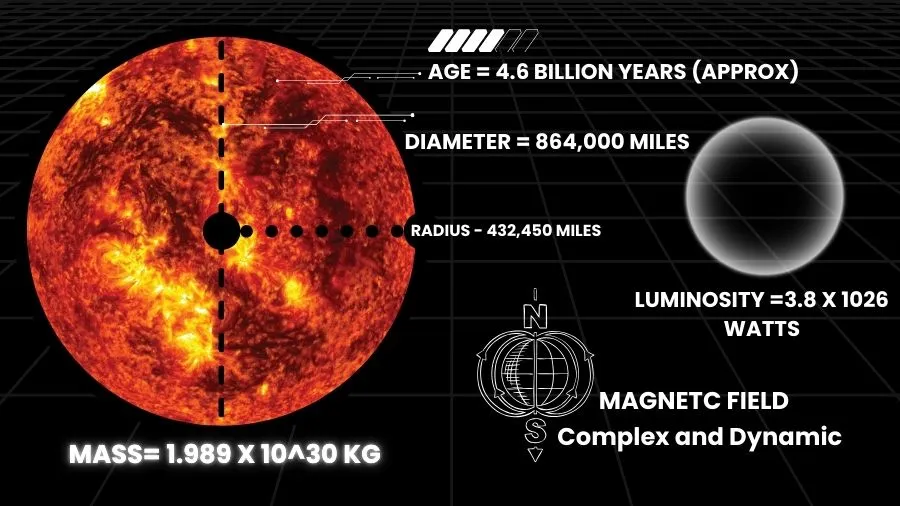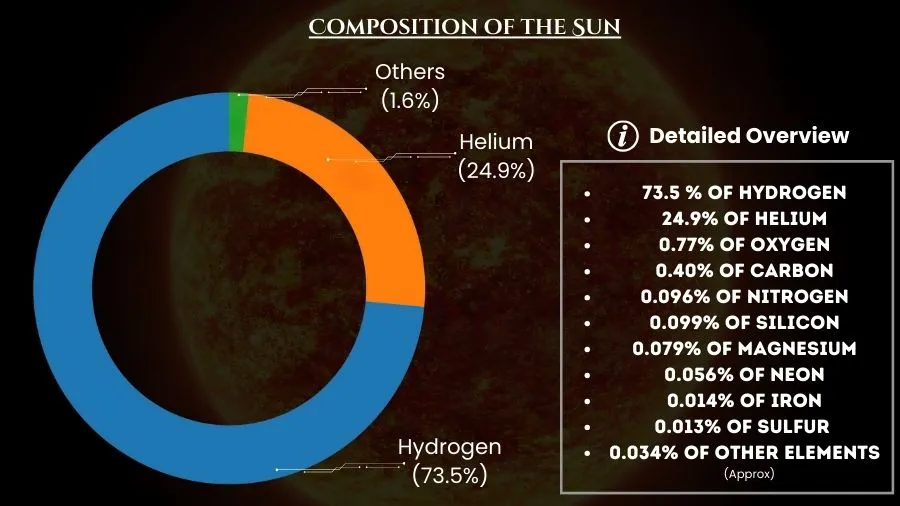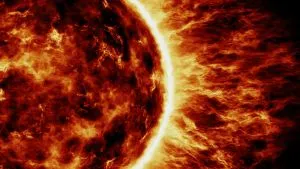The sun is an ordinary star classified under the G2V star, where the G2 stands for the second hottest stars of the yellow G class and V represents a main sequence or dwarf star, with an absolute stellar magnitude of 4.8.
The Sun produces energy by Hydrogen fusion to form Helium through a proton-proton (p-p) chain reaction and releases the energy in the form of radiation. The Sun is an enormous ball of plasma that is squeezed and kept together by its gravitational pull. Being at the center of our solar system, it has a significant impact on both the weather in space and on Earth.
Basic Parameters of the Sun
The average distance between the Earth and the Sun is 149.6 million kilometers, which is about 108 times the Earth’s diameter. It takes 8 minutes and 20 seconds for light to travel.
- Mass= 1.989 x 1030 kg
- Radius =696,340 km (432,450 miles)
- Diameter =1.39 million km (864,000 miles)
- Age =Approximately, 4.6 billion years
- Luminosity =3.8 x 1026 watts
- Magnetic Field =Complex and dynamic.

Composition of the Sun
The Sun contains nearly 73.5 % of hydrogen, 24.9% of Helium, 0.77% of oxygen, 0.40% of carbon, 0.096% of nitrogen, 0.099% of silicon, 0.079% of magnesium, 0.056% of neon, 0.014% of iron, 0.013% of sulfur and 0.034% of other elements.

Solar Activities of the Sun
It is the evidence that our Sun is well and alive. Sunspots, solar flares, CMEs and solar wind are few solar events that take place on the sun. These processes are fueled by the Sun’s internal dynamics and magnetic field and these impact the space environment, and function in forming Earth’s magnetosphere and upper atmosphere.
For the purpose of forecasting space weather, comprehending the Sun-Earth relationship, and expanding our grasp of astrophysics and stellar development, monitoring and studying solar activity provides important information.
Quiet sun and Active sun
Different levels of solar activity are described using the terms “Quiet Sun” and “Active Sun.” A time when solar activity is noticeably low is referred to as the quiet Sun. The Sun encounters few sunspots and exhibits little to no activity in the form of solar flares or Coronal Mass Ejections (CMEs) during this phase.
The surface of the tranquil Sun appears relatively serene and smooth, and its magnetic field experiences fewer disruptions. This period frequently coincides with the solar cycle’s minimum, which happens every 11 years on average.
On the other hand, the term “active Sun” refers to a time when solar activity has increased. Sunspots, solar flares, and CMEs occur more frequently during this phase. Greater magnetic field disruptions, which result in more sunspot generation and more intense solar events, are indicative of an active Sun.
This period frequently coincides with the solar cycle maximum, which happens every 11 years on average. The solar cycle, commonly referred to as the sunspot cycle or the solar magnetic activity cycle, includes the transition between the quiet Sun and the active Sun.
We are currently in the 25th solar cycle, during which the sun is very active and exhibiting enhanced solar activities. There have reportedly been observations of a sizable sunspot on the sun, as well as frequent reports of solar flares and CMEs, some of which are Earth-directed, and vigorous occurrences of the Aurora Borealis.
According to scientists, there may be peaks in solar activity in the upcoming years that could even cause power outages.
Sunspot
A sunspot is a dark, substantially colder patch that develops on the surface of the Sun. It is a transient phenomenon brought on by the Sun’s intense magnetic activity. Sunspots often appear as dark spots or patches with an umbra (dark center) and penumbra (lighter region) around them.

They are known to undergo periodic cycles of activity, with the number of them varying over an approximately 11-year cycle known as the solar cycle. Sunspots are typically associated with strong magnetic activity, and they frequently occur in groups or clusters.
They can last anywhere from a few days to a few weeks before fading away. Scientists pay special attention to sunspots because they are significant indications of solar activity.
They may be related to the violent releases of energy and particles from the Sun known as solar flares and coronal mass ejections.
Solar wind
The solar wind, a flow of charged particles, mostly protons and electrons, is continually emitted by the Sun. The magnetic field of the Sun is transported across the solar system by it. The solar wind and Earth’s magnetosphere interact to produce natural phenomena like auroras and have an impact on the space environment surrounding planets and other celestial bodies.

The heated, outermost layer of the Sun’s atmosphere, known as the corona, is the source of solar wind. The temperature of the corona can reach millions of degrees Celsius.
The energy required for particles to escape the Sun’s gravitational pull and flow outward is provided by the high temperature and the Sun’s tremendous magnetic activity.
The solar wind’s velocity varies, but it normally falls between 300 and 800 kilometers per second (km/s). Sometimes, during times of intense solar activity, the solar wind can travel at rates greater than 1,000 km/s. When solar wind interacts with the Earth’s magnetosphere, velocity is a key factor.
Solar flares
Solar flares are abrupt, strong energy discharges from the Sun’s atmosphere. They are caused by the sudden emission of a massive amount of energy, including light, X-rays, and energetic particles, as a result of the rapid reconfiguration of magnetic fields.

Solar flares have the potential to disrupt radio communications and Satellite Operations by disrupting Earth’s upper atmosphere. Solar flares are formed as a consequence of the magnetic field of the sun changing rapidly.
The magnetic fields in the Sun’s atmosphere can twist and tension, storing a lot of energy. The energy is quickly released, producing a solar flare, when the magnetic field lines abruptly rearrange or snap into a more stable shape.
A sizeable portion of the magnetic energy that has been stored is transformed into different types of energy during a solar flare.
Visible light, ultraviolet (UV) radiation, X-rays, and gamma rays are only a few of the many wavelengths of electromagnetic radiation that are released as the majority of the energy. Radio communications and navigational systems may be interfered with, and this radiation may have an impact on the ionosphere of the Earth.
Coronal Mass Ejections
CMEs are enormous plasma and magnetic field outbursts from the Sun’s corona. These occurrences send massive amounts of material into space quickly. When a CME strikes Earth, it may interact with the magnetosphere and could trigger geomagnetic storms that could impact the planet’s magnetic field and interfere with satellites, electrical grids, and communication systems.
Understanding CME properties and behavior is critical for forecasting space weather, safeguarding satellites and space missions, and limiting potential effects on Earth’s technological infrastructure. CMEs are a fundamental component of solar activity.
A CME’s structure and composition consists of a core, a bright front known as the leading edge, and a sheath. The majority of the expelled plasma and magnetic fields are contained in the core. When viewed from spacecraft, the CME’s leading edge frequently appears as a bright front due to its fast motion and interactions with the solar wind. Following the leading edge is the sheath, an area of compressed and turbulent solar wind.
Read More: What are Coronal Mass Ejections? Origin and Detection
Prominences
Prominences are enormous, brilliant, and frequently loop-shaped suspensions of comparatively cool plasma in the heated corona of the Sun. They can extend thousands of kilometers and are held to the Sun’s surface by magnetic fields. A CME can be released when prominences abruptly erupt after being stable for several weeks.
When the Sun is eclipsed by another body of light or when using specialized solar telescopes, prominences can often be seen along the margins of the Sun’s visible disc. Quiescent prominences and eruptive prominences are the two basic forms that can be differentiated amongst them.
It is important to note that understanding and detecting solar activities are crucial for forecasting space weather. When solar flares or CMEs accompany eruptive prominences, the solar wind may be disturbed, which could affect the Earth’s magnetosphere and result in geomagnetic storms and other disruptions to various technological systems.










